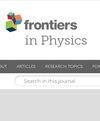利用高帧率成像技术检测三维自然脉冲波 (PW) 以确定各向异性特征
IF 1.9
3区 物理与天体物理
Q2 PHYSICS, MULTIDISCIPLINARY
引用次数: 0
摘要
导言:大量研究表明,自然机械波具有评估心肌弹性特性的潜力。当主动脉瓣和二尖瓣关闭时,会产生剪切波,这有助于了解组织的硬度。此外,"心房踢"(AK)产生的波类似于动脉中的脉搏波(PW),为评估组织僵硬度提供了另一种方法。然而,组织各向异性也会影响脉搏波的传播,这一点目前尚未得到充分探索。本研究旨在通过研究各向异性对脉搏波在模型中传播的影响来填补这一空白。通过拉伸和扭曲材料,在两组两次冻融循环之间诱导各向异性。研究首先测试并验证了利用剪切波成像技术(通过估算不同探头角度下的剪切波速度)制作螺旋各向异性血管模型的程序。利用与蠕动泵同步的平面波超声断层扫描技术,进行三维高帧率成像,并用于检测每个制作的血管模型的 PW 三维传播模式。最后,研究尝试利用脉冲波传播角度提取血管的各向异性系数。结果各向同性血管的剪切波成像结果显示,每个探头角度的数值非常相似。相反,轴向各向异性血管的结果显示,在与血管长轴相对应的约 0° 处,剪切波速度较高。最后,螺旋各向异性的结果显示,剪切波速度值从-20°到 20°不断增加。在轴向模型中,脉冲波的波面垂直于血管长轴,而在螺旋各向异性血管模型中,脉冲波的波面是定向的。结果表明,通过在冻融循环中拉伸和扭转 PVA 血管模型材料,可以诱导血管各向异性。研究结果还表明,容器的各向异性会影响脉冲波的传播角。估算脉冲波传播角度可能有助于描述自然存在这种波的器官中组织的各向异性。本文章由计算机程序翻译,如有差异,请以英文原文为准。
Detection of natural pulse waves (PWs) in 3D using high frame rate imaging for anisotropy characterization
IntroductionNumerous studies have shown that natural mechanical waves have the potential to assess the elastic properties of the myocardium. When the Aortic and Mitral valves close, a shear wave is produced, which provides insights into tissue stiffness. In addition, the Atrial Kick (AK) generates a wave similar to Pulse Waves (PWs) in arteries, providing another way to assess tissue stiffness. However, tissue anisotropy can also impact PW propagation, which is currently underexplored. This study aims to address this gap by investigating the impact of anisotropy on PW propagation in a phantom.MethodsTube phantoms were created using Polyvinyl Alcohol (PVA). Anisotropy was induced between two sets of two freeze-thaw cycles by stretching and twisting the material. The study first tests and validates the procedure of making helical anisotropic vessel phantoms using the shear wave imaging technique (by estimating the shear wave speed at different probe angles). Using plane wave ultrasound tomography synchronized with a peristaltic pump, 3D high frame rate imaging is performed and used to detect the 3D propagation pattern of PW for each manufactured vessel phantom. Finally, the study attempts to extract the anisotropic coefficient of the vessel using pulse wave propagation angle.ResultsThe Shear wave imaging results obtained for the isotropic vessel show very similar values for each probe angle. On the contrary, the results obtained for the axial anisotropy vessel show a region with a higher shear wave speed at about 0°, corresponding to the long axis of the vessel. Finally, the results obtained for the helical anisotropy depicted increasing shear wave velocity value from −20° to 20°. For the axial phantom, the wavefront of the pulse wave is perpendicular to the long axis of the vessel, while oriented for the helical anisotropic vessels phantom. The pulse wave propagation angle increased with the number of twists made during the vessel manufacturing.DiscussionThe results show that anisotropy can be induced in PVA vessel phantoms by stretching and twisting the material in freeze-thaw cycles. The findings also suggest that vessel anisotropy affects pulse wave propagation angles. Estimating the pulse wave propagation angle may be interesting in characterizing tissue anisotropy in organs where such waves are naturally present.
求助全文
通过发布文献求助,成功后即可免费获取论文全文。
去求助
来源期刊

Frontiers in Physics
Mathematics-Mathematical Physics
CiteScore
4.50
自引率
6.50%
发文量
1215
审稿时长
12 weeks
期刊介绍:
Frontiers in Physics publishes rigorously peer-reviewed research across the entire field, from experimental, to computational and theoretical physics. This multidisciplinary open-access journal is at the forefront of disseminating and communicating scientific knowledge and impactful discoveries to researchers, academics, engineers and the public worldwide.
 求助内容:
求助内容: 应助结果提醒方式:
应助结果提醒方式:


